A Detailed Case Study on Special Education and Psychology of Children
VerifiedAdded on 2023/06/10
|6
|1672
|459
Case Study
AI Summary
This case study explores the critical role of special education in supporting children with special learning disabilities, who often develop negative perceptions of school and education. It highlights the necessity of tailored educational approaches to address individual differences and needs, including those with autism, epilepsy, and various impairments. The study aims to understand how a child with specific learning difficulties navigates challenges in learning and achieves social success, assessing their biographical data, medical and educational history, and family background. It reviews literature on Global Development Delay (GDD), its causes, symptoms, and the importance of early intervention services like occupational, physical, and speech therapy. The study emphasizes early detection and prevention strategies to mitigate the long-term risks associated with developmental disabilities, advocating for expanded prevention programs and early interventions to support children with challenging behaviors and mental health conditions.
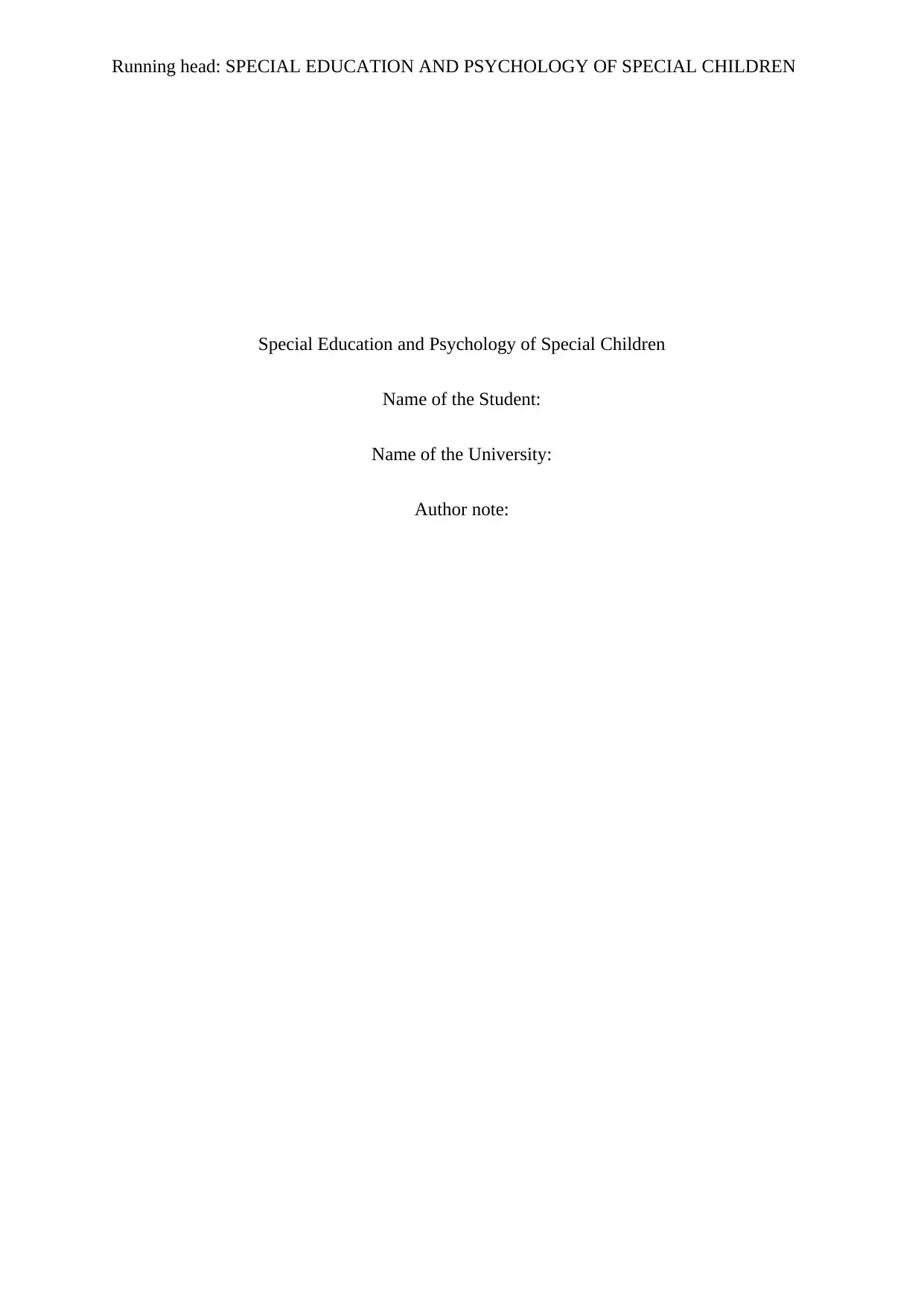
Running head: SPECIAL EDUCATION AND PSYCHOLOGY OF SPECIAL CHILDREN
Special Education and Psychology of Special Children
Name of the Student:
Name of the University:
Author note:
Special Education and Psychology of Special Children
Name of the Student:
Name of the University:
Author note:
Paraphrase This Document
Need a fresh take? Get an instant paraphrase of this document with our AI Paraphraser
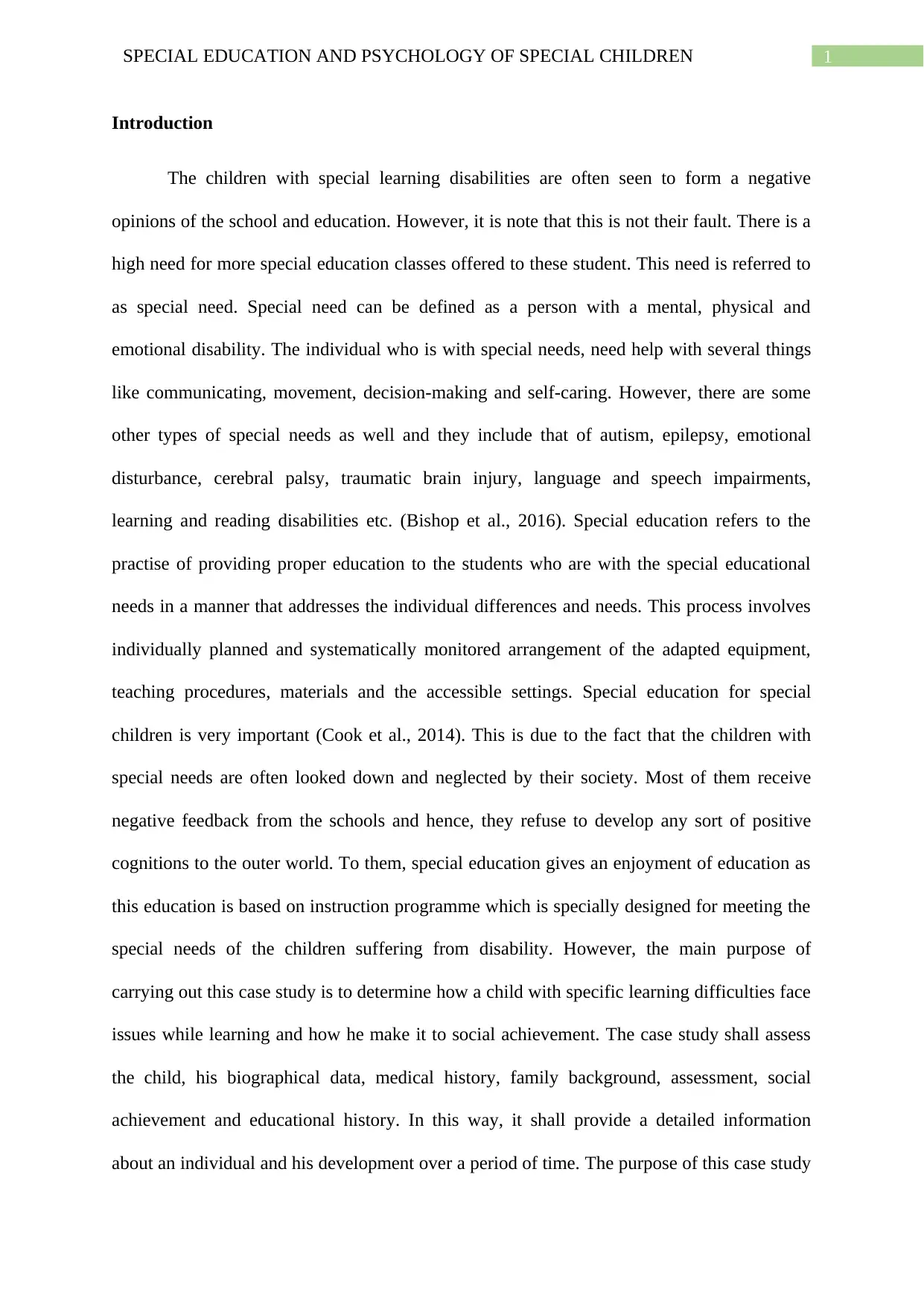
1SPECIAL EDUCATION AND PSYCHOLOGY OF SPECIAL CHILDREN
Introduction
The children with special learning disabilities are often seen to form a negative
opinions of the school and education. However, it is note that this is not their fault. There is a
high need for more special education classes offered to these student. This need is referred to
as special need. Special need can be defined as a person with a mental, physical and
emotional disability. The individual who is with special needs, need help with several things
like communicating, movement, decision-making and self-caring. However, there are some
other types of special needs as well and they include that of autism, epilepsy, emotional
disturbance, cerebral palsy, traumatic brain injury, language and speech impairments,
learning and reading disabilities etc. (Bishop et al., 2016). Special education refers to the
practise of providing proper education to the students who are with the special educational
needs in a manner that addresses the individual differences and needs. This process involves
individually planned and systematically monitored arrangement of the adapted equipment,
teaching procedures, materials and the accessible settings. Special education for special
children is very important (Cook et al., 2014). This is due to the fact that the children with
special needs are often looked down and neglected by their society. Most of them receive
negative feedback from the schools and hence, they refuse to develop any sort of positive
cognitions to the outer world. To them, special education gives an enjoyment of education as
this education is based on instruction programme which is specially designed for meeting the
special needs of the children suffering from disability. However, the main purpose of
carrying out this case study is to determine how a child with specific learning difficulties face
issues while learning and how he make it to social achievement. The case study shall assess
the child, his biographical data, medical history, family background, assessment, social
achievement and educational history. In this way, it shall provide a detailed information
about an individual and his development over a period of time. The purpose of this case study
Introduction
The children with special learning disabilities are often seen to form a negative
opinions of the school and education. However, it is note that this is not their fault. There is a
high need for more special education classes offered to these student. This need is referred to
as special need. Special need can be defined as a person with a mental, physical and
emotional disability. The individual who is with special needs, need help with several things
like communicating, movement, decision-making and self-caring. However, there are some
other types of special needs as well and they include that of autism, epilepsy, emotional
disturbance, cerebral palsy, traumatic brain injury, language and speech impairments,
learning and reading disabilities etc. (Bishop et al., 2016). Special education refers to the
practise of providing proper education to the students who are with the special educational
needs in a manner that addresses the individual differences and needs. This process involves
individually planned and systematically monitored arrangement of the adapted equipment,
teaching procedures, materials and the accessible settings. Special education for special
children is very important (Cook et al., 2014). This is due to the fact that the children with
special needs are often looked down and neglected by their society. Most of them receive
negative feedback from the schools and hence, they refuse to develop any sort of positive
cognitions to the outer world. To them, special education gives an enjoyment of education as
this education is based on instruction programme which is specially designed for meeting the
special needs of the children suffering from disability. However, the main purpose of
carrying out this case study is to determine how a child with specific learning difficulties face
issues while learning and how he make it to social achievement. The case study shall assess
the child, his biographical data, medical history, family background, assessment, social
achievement and educational history. In this way, it shall provide a detailed information
about an individual and his development over a period of time. The purpose of this case study
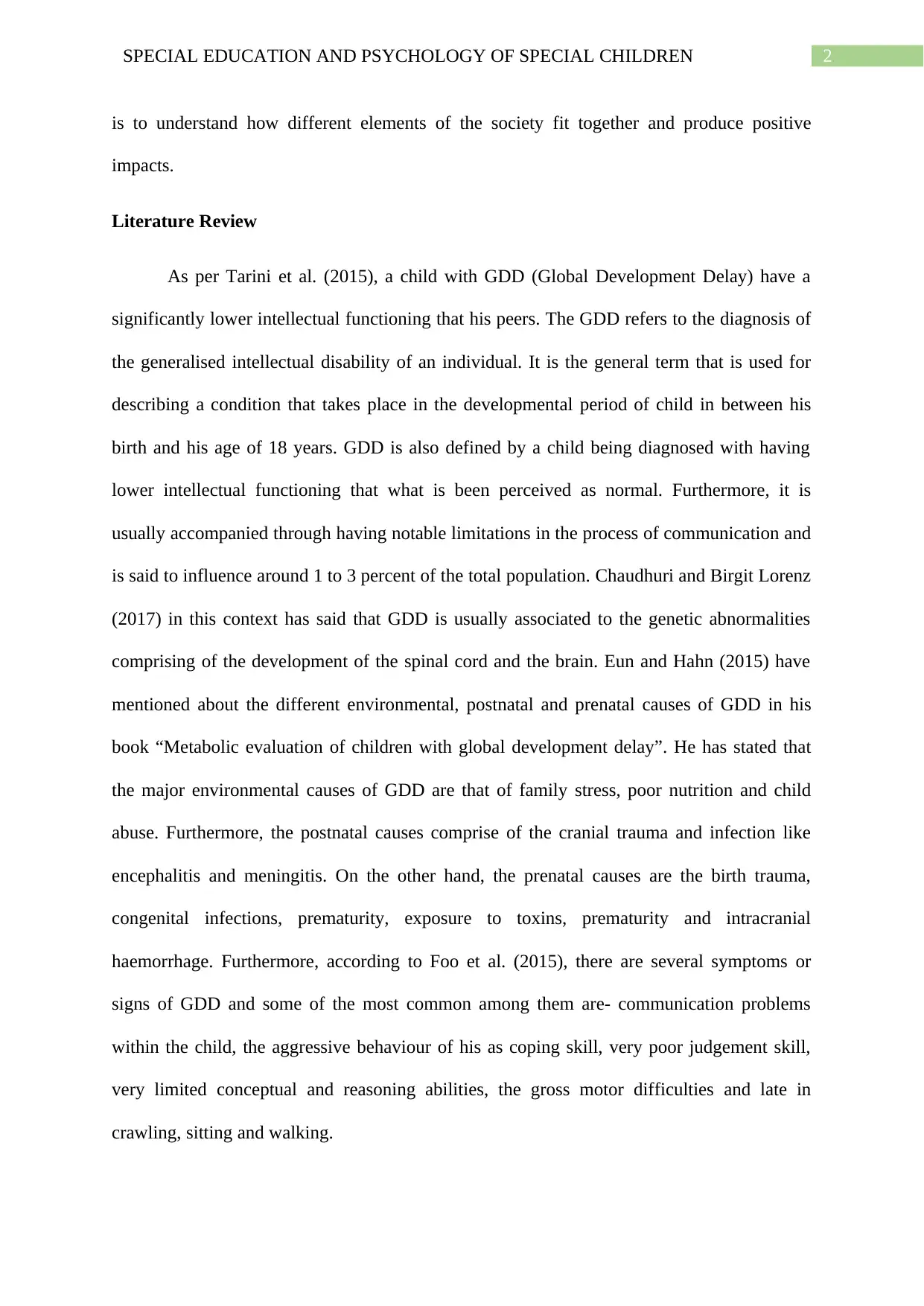
2SPECIAL EDUCATION AND PSYCHOLOGY OF SPECIAL CHILDREN
is to understand how different elements of the society fit together and produce positive
impacts.
Literature Review
As per Tarini et al. (2015), a child with GDD (Global Development Delay) have a
significantly lower intellectual functioning that his peers. The GDD refers to the diagnosis of
the generalised intellectual disability of an individual. It is the general term that is used for
describing a condition that takes place in the developmental period of child in between his
birth and his age of 18 years. GDD is also defined by a child being diagnosed with having
lower intellectual functioning that what is been perceived as normal. Furthermore, it is
usually accompanied through having notable limitations in the process of communication and
is said to influence around 1 to 3 percent of the total population. Chaudhuri and Birgit Lorenz
(2017) in this context has said that GDD is usually associated to the genetic abnormalities
comprising of the development of the spinal cord and the brain. Eun and Hahn (2015) have
mentioned about the different environmental, postnatal and prenatal causes of GDD in his
book “Metabolic evaluation of children with global development delay”. He has stated that
the major environmental causes of GDD are that of family stress, poor nutrition and child
abuse. Furthermore, the postnatal causes comprise of the cranial trauma and infection like
encephalitis and meningitis. On the other hand, the prenatal causes are the birth trauma,
congenital infections, prematurity, exposure to toxins, prematurity and intracranial
haemorrhage. Furthermore, according to Foo et al. (2015), there are several symptoms or
signs of GDD and some of the most common among them are- communication problems
within the child, the aggressive behaviour of his as coping skill, very poor judgement skill,
very limited conceptual and reasoning abilities, the gross motor difficulties and late in
crawling, sitting and walking.
is to understand how different elements of the society fit together and produce positive
impacts.
Literature Review
As per Tarini et al. (2015), a child with GDD (Global Development Delay) have a
significantly lower intellectual functioning that his peers. The GDD refers to the diagnosis of
the generalised intellectual disability of an individual. It is the general term that is used for
describing a condition that takes place in the developmental period of child in between his
birth and his age of 18 years. GDD is also defined by a child being diagnosed with having
lower intellectual functioning that what is been perceived as normal. Furthermore, it is
usually accompanied through having notable limitations in the process of communication and
is said to influence around 1 to 3 percent of the total population. Chaudhuri and Birgit Lorenz
(2017) in this context has said that GDD is usually associated to the genetic abnormalities
comprising of the development of the spinal cord and the brain. Eun and Hahn (2015) have
mentioned about the different environmental, postnatal and prenatal causes of GDD in his
book “Metabolic evaluation of children with global development delay”. He has stated that
the major environmental causes of GDD are that of family stress, poor nutrition and child
abuse. Furthermore, the postnatal causes comprise of the cranial trauma and infection like
encephalitis and meningitis. On the other hand, the prenatal causes are the birth trauma,
congenital infections, prematurity, exposure to toxins, prematurity and intracranial
haemorrhage. Furthermore, according to Foo et al. (2015), there are several symptoms or
signs of GDD and some of the most common among them are- communication problems
within the child, the aggressive behaviour of his as coping skill, very poor judgement skill,
very limited conceptual and reasoning abilities, the gross motor difficulties and late in
crawling, sitting and walking.
⊘ This is a preview!⊘
Do you want full access?
Subscribe today to unlock all pages.

Trusted by 1+ million students worldwide
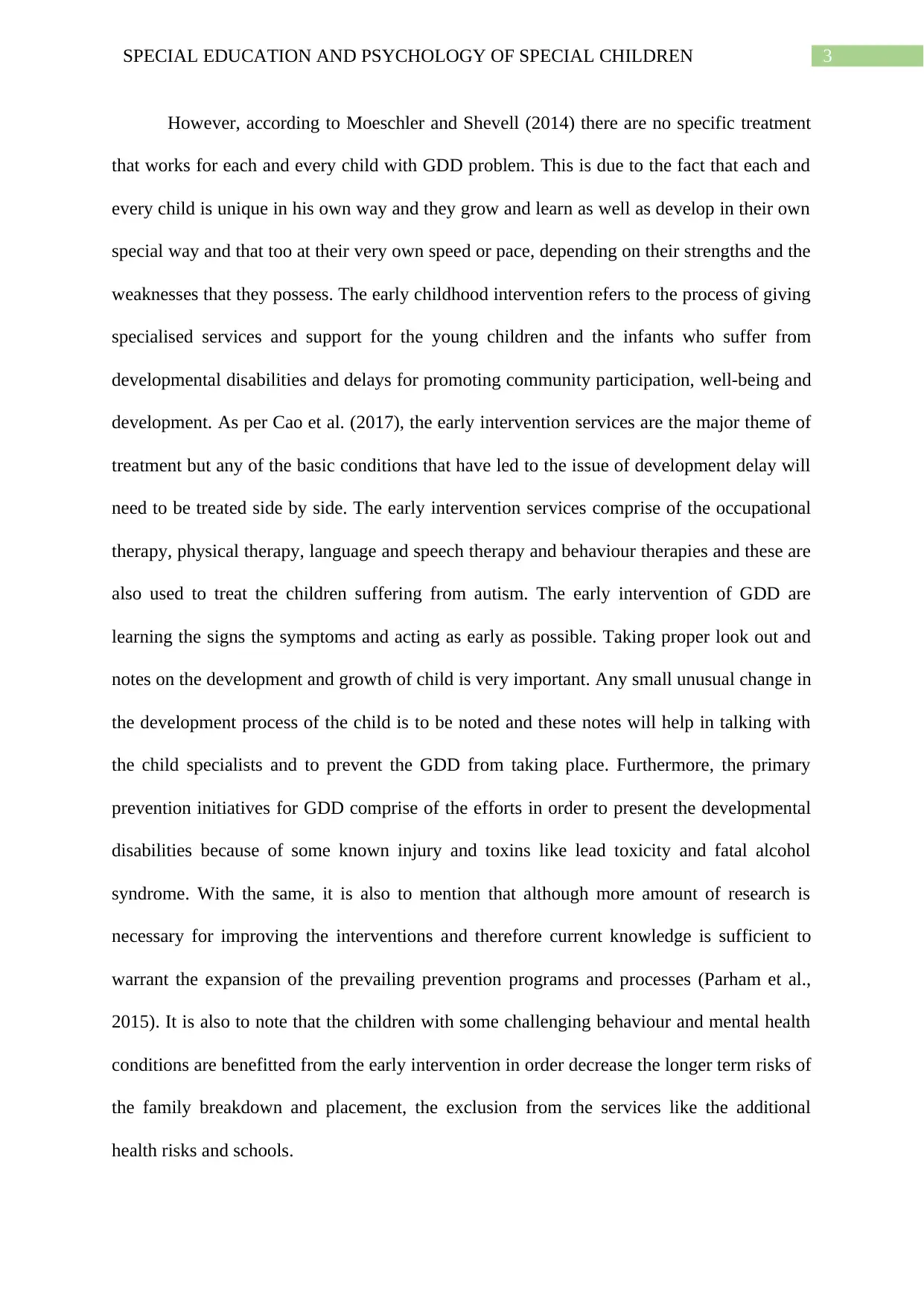
3SPECIAL EDUCATION AND PSYCHOLOGY OF SPECIAL CHILDREN
However, according to Moeschler and Shevell (2014) there are no specific treatment
that works for each and every child with GDD problem. This is due to the fact that each and
every child is unique in his own way and they grow and learn as well as develop in their own
special way and that too at their very own speed or pace, depending on their strengths and the
weaknesses that they possess. The early childhood intervention refers to the process of giving
specialised services and support for the young children and the infants who suffer from
developmental disabilities and delays for promoting community participation, well-being and
development. As per Cao et al. (2017), the early intervention services are the major theme of
treatment but any of the basic conditions that have led to the issue of development delay will
need to be treated side by side. The early intervention services comprise of the occupational
therapy, physical therapy, language and speech therapy and behaviour therapies and these are
also used to treat the children suffering from autism. The early intervention of GDD are
learning the signs the symptoms and acting as early as possible. Taking proper look out and
notes on the development and growth of child is very important. Any small unusual change in
the development process of the child is to be noted and these notes will help in talking with
the child specialists and to prevent the GDD from taking place. Furthermore, the primary
prevention initiatives for GDD comprise of the efforts in order to present the developmental
disabilities because of some known injury and toxins like lead toxicity and fatal alcohol
syndrome. With the same, it is also to mention that although more amount of research is
necessary for improving the interventions and therefore current knowledge is sufficient to
warrant the expansion of the prevailing prevention programs and processes (Parham et al.,
2015). It is also to note that the children with some challenging behaviour and mental health
conditions are benefitted from the early intervention in order decrease the longer term risks of
the family breakdown and placement, the exclusion from the services like the additional
health risks and schools.
However, according to Moeschler and Shevell (2014) there are no specific treatment
that works for each and every child with GDD problem. This is due to the fact that each and
every child is unique in his own way and they grow and learn as well as develop in their own
special way and that too at their very own speed or pace, depending on their strengths and the
weaknesses that they possess. The early childhood intervention refers to the process of giving
specialised services and support for the young children and the infants who suffer from
developmental disabilities and delays for promoting community participation, well-being and
development. As per Cao et al. (2017), the early intervention services are the major theme of
treatment but any of the basic conditions that have led to the issue of development delay will
need to be treated side by side. The early intervention services comprise of the occupational
therapy, physical therapy, language and speech therapy and behaviour therapies and these are
also used to treat the children suffering from autism. The early intervention of GDD are
learning the signs the symptoms and acting as early as possible. Taking proper look out and
notes on the development and growth of child is very important. Any small unusual change in
the development process of the child is to be noted and these notes will help in talking with
the child specialists and to prevent the GDD from taking place. Furthermore, the primary
prevention initiatives for GDD comprise of the efforts in order to present the developmental
disabilities because of some known injury and toxins like lead toxicity and fatal alcohol
syndrome. With the same, it is also to mention that although more amount of research is
necessary for improving the interventions and therefore current knowledge is sufficient to
warrant the expansion of the prevailing prevention programs and processes (Parham et al.,
2015). It is also to note that the children with some challenging behaviour and mental health
conditions are benefitted from the early intervention in order decrease the longer term risks of
the family breakdown and placement, the exclusion from the services like the additional
health risks and schools.
Paraphrase This Document
Need a fresh take? Get an instant paraphrase of this document with our AI Paraphraser
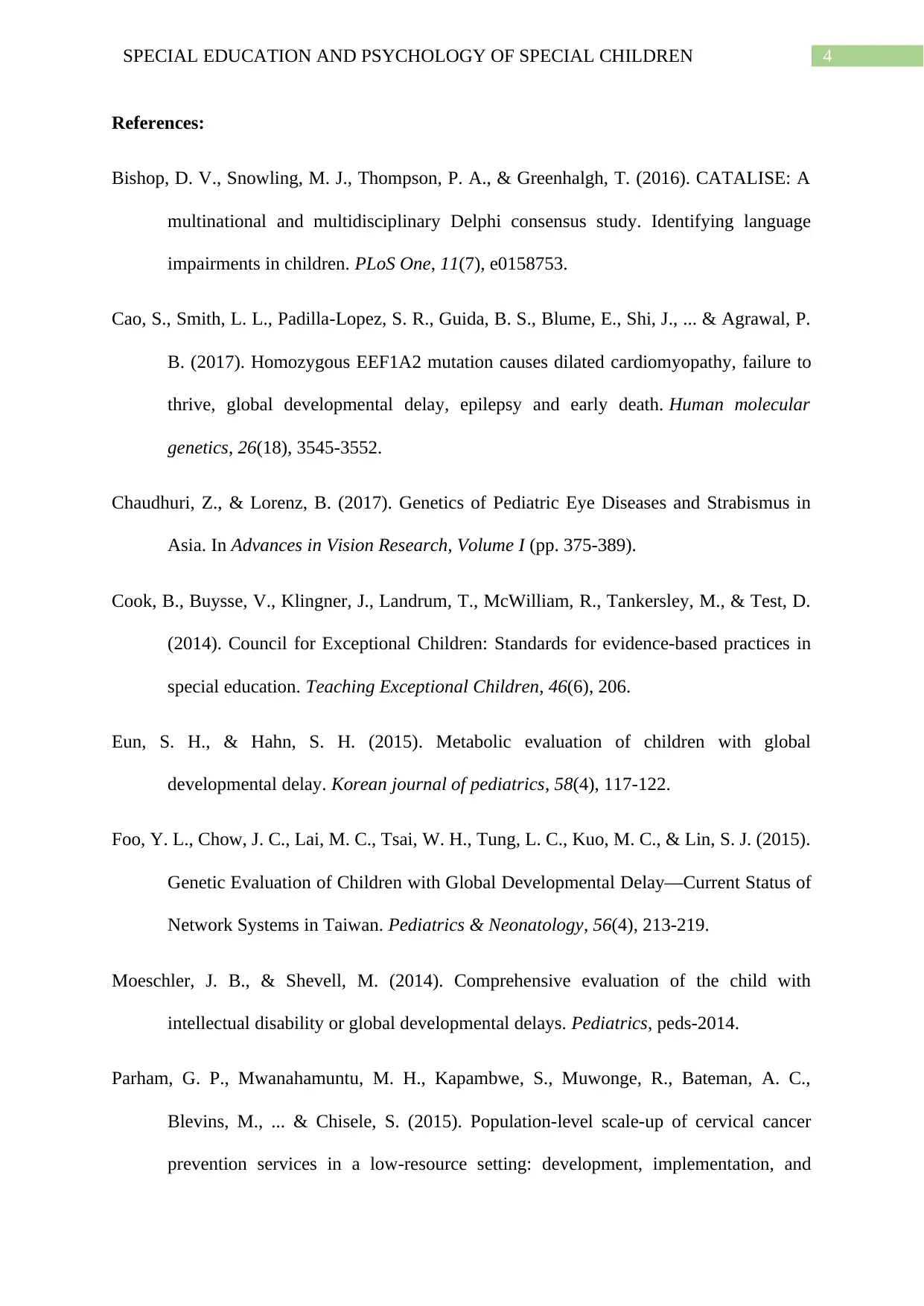
4SPECIAL EDUCATION AND PSYCHOLOGY OF SPECIAL CHILDREN
References:
Bishop, D. V., Snowling, M. J., Thompson, P. A., & Greenhalgh, T. (2016). CATALISE: A
multinational and multidisciplinary Delphi consensus study. Identifying language
impairments in children. PLoS One, 11(7), e0158753.
Cao, S., Smith, L. L., Padilla-Lopez, S. R., Guida, B. S., Blume, E., Shi, J., ... & Agrawal, P.
B. (2017). Homozygous EEF1A2 mutation causes dilated cardiomyopathy, failure to
thrive, global developmental delay, epilepsy and early death. Human molecular
genetics, 26(18), 3545-3552.
Chaudhuri, Z., & Lorenz, B. (2017). Genetics of Pediatric Eye Diseases and Strabismus in
Asia. In Advances in Vision Research, Volume I (pp. 375-389).
Cook, B., Buysse, V., Klingner, J., Landrum, T., McWilliam, R., Tankersley, M., & Test, D.
(2014). Council for Exceptional Children: Standards for evidence-based practices in
special education. Teaching Exceptional Children, 46(6), 206.
Eun, S. H., & Hahn, S. H. (2015). Metabolic evaluation of children with global
developmental delay. Korean journal of pediatrics, 58(4), 117-122.
Foo, Y. L., Chow, J. C., Lai, M. C., Tsai, W. H., Tung, L. C., Kuo, M. C., & Lin, S. J. (2015).
Genetic Evaluation of Children with Global Developmental Delay—Current Status of
Network Systems in Taiwan. Pediatrics & Neonatology, 56(4), 213-219.
Moeschler, J. B., & Shevell, M. (2014). Comprehensive evaluation of the child with
intellectual disability or global developmental delays. Pediatrics, peds-2014.
Parham, G. P., Mwanahamuntu, M. H., Kapambwe, S., Muwonge, R., Bateman, A. C.,
Blevins, M., ... & Chisele, S. (2015). Population-level scale-up of cervical cancer
prevention services in a low-resource setting: development, implementation, and
References:
Bishop, D. V., Snowling, M. J., Thompson, P. A., & Greenhalgh, T. (2016). CATALISE: A
multinational and multidisciplinary Delphi consensus study. Identifying language
impairments in children. PLoS One, 11(7), e0158753.
Cao, S., Smith, L. L., Padilla-Lopez, S. R., Guida, B. S., Blume, E., Shi, J., ... & Agrawal, P.
B. (2017). Homozygous EEF1A2 mutation causes dilated cardiomyopathy, failure to
thrive, global developmental delay, epilepsy and early death. Human molecular
genetics, 26(18), 3545-3552.
Chaudhuri, Z., & Lorenz, B. (2017). Genetics of Pediatric Eye Diseases and Strabismus in
Asia. In Advances in Vision Research, Volume I (pp. 375-389).
Cook, B., Buysse, V., Klingner, J., Landrum, T., McWilliam, R., Tankersley, M., & Test, D.
(2014). Council for Exceptional Children: Standards for evidence-based practices in
special education. Teaching Exceptional Children, 46(6), 206.
Eun, S. H., & Hahn, S. H. (2015). Metabolic evaluation of children with global
developmental delay. Korean journal of pediatrics, 58(4), 117-122.
Foo, Y. L., Chow, J. C., Lai, M. C., Tsai, W. H., Tung, L. C., Kuo, M. C., & Lin, S. J. (2015).
Genetic Evaluation of Children with Global Developmental Delay—Current Status of
Network Systems in Taiwan. Pediatrics & Neonatology, 56(4), 213-219.
Moeschler, J. B., & Shevell, M. (2014). Comprehensive evaluation of the child with
intellectual disability or global developmental delays. Pediatrics, peds-2014.
Parham, G. P., Mwanahamuntu, M. H., Kapambwe, S., Muwonge, R., Bateman, A. C.,
Blevins, M., ... & Chisele, S. (2015). Population-level scale-up of cervical cancer
prevention services in a low-resource setting: development, implementation, and
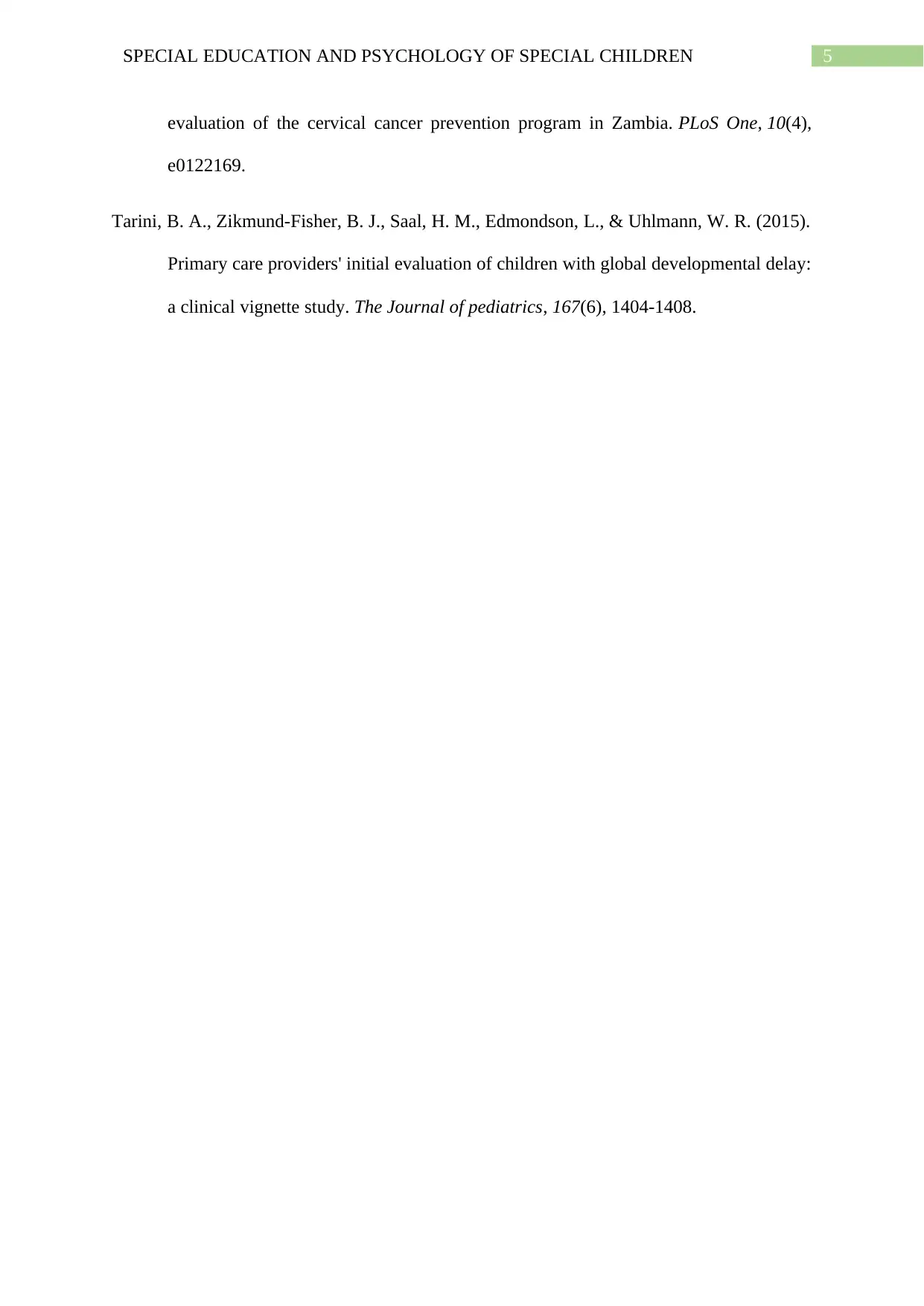
5SPECIAL EDUCATION AND PSYCHOLOGY OF SPECIAL CHILDREN
evaluation of the cervical cancer prevention program in Zambia. PLoS One, 10(4),
e0122169.
Tarini, B. A., Zikmund-Fisher, B. J., Saal, H. M., Edmondson, L., & Uhlmann, W. R. (2015).
Primary care providers' initial evaluation of children with global developmental delay:
a clinical vignette study. The Journal of pediatrics, 167(6), 1404-1408.
evaluation of the cervical cancer prevention program in Zambia. PLoS One, 10(4),
e0122169.
Tarini, B. A., Zikmund-Fisher, B. J., Saal, H. M., Edmondson, L., & Uhlmann, W. R. (2015).
Primary care providers' initial evaluation of children with global developmental delay:
a clinical vignette study. The Journal of pediatrics, 167(6), 1404-1408.
⊘ This is a preview!⊘
Do you want full access?
Subscribe today to unlock all pages.

Trusted by 1+ million students worldwide
1 out of 6
Related Documents
Your All-in-One AI-Powered Toolkit for Academic Success.
+13062052269
info@desklib.com
Available 24*7 on WhatsApp / Email
![[object Object]](/_next/static/media/star-bottom.7253800d.svg)
Unlock your academic potential
Copyright © 2020–2025 A2Z Services. All Rights Reserved. Developed and managed by ZUCOL.





